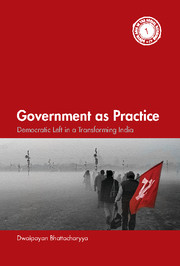Book contents
2 - Consolidation: Land Reforms
Published online by Cambridge University Press: 05 March 2016
Summary
After forming the government, the parliamentary left in West Bengal implemented some of the country's most effective land reform laws that had a long-term impact on the structure of rural property and power. Although the stated intent was to reduce poverty and encourage a just sharing of agrarian assets by reducing age old exploitation of poor cultivators by a handful of landlords, these reforms also helped the left build a solid constituency of support that stood by it in every election for decades. The use of an economic policy as a political tool for organized support required skilful manoeuvring since land reforms could also split the rural classes and pit one against the other. To garner a composite electoral constituency from the rural population that included its ‘class-friends’ as well as ‘class-enemies’, the left modified its radicalism and mellowed down its rhetoric. The shift in the left's ideological position was attempted in a strategic and calibrated way so as not to appear ‘revisionist’ or ‘class collaborationist’. While it helped the left's electoral prospect in the state, it also created some long-term insoluble problems.
Land reforms had been a demand of the nationalist bourgeoisie in its attempt to enlist support from the peasantry during the anticolonial mobilization. A resolution of the Agrarian Reforms Committee of the Indian National Congress in 1935 stated that a ‘fundamental method of improving village life’ was to introduce ‘a system of peasant proprietorship under which the tiller of the soil is himself the owner of it and pays revenues direct to the government without the intervention of any zamindar or taluqdar’. Post-independence, the First Five Year Plan (1951–56) echoed these concerns despite its care not to hurt the property rights of the intermediary classes. In some states, policies were made to eliminate big tax-farming zamindars which effectively ended up increasing the power of the rich peasants and the intermediary landlords. The demand for ‘land to the tiller’ figured in Congress party's agenda only until the mid-1950s (Harriss, 2012). The party put land reforms to rest in its annual meeting in Nagpur in 1959, when Charan Singh – a North Indian leader of rich farmers – made sure that a reformist draft entitled ‘Resolution on Agricultural Organisational Pattern’ was rejected.
- Type
- Chapter
- Information
- Government as PracticeDemocratic Left in a Transforming India, pp. 56 - 88Publisher: Cambridge University PressPrint publication year: 2016



